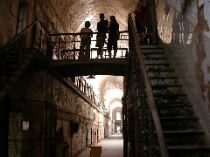
This week at the Weekly, my review of the Janet Cardiff/George Bures Miller audio work, “Pandemonium” at Eastern State Penitentiary. Here’s the link to PW and here’s the piece. I’m running it with some photos I took when I visited the prison last week.
Jailhouse Flop
The first thing to know about Janet Cardiff and her husband George Bures Miller’s “Pandemonium” at Eastern State Penitentiary is that the piece isn’t a signature Cardiff audio walk. (image is visitors silhouetted in front of the cavernous Cellblock 7 in which the Cardiff/Miller piece is housed.)
Unlike Cardiff’s “Her Long Black Hair“-a narrated audio walk in Central Park sponsored by the Public Art Fund that weaves a fictitious story of a missing woman and some found photographs-“Pandemonium” requires no headgear and exudes no fiction or pulp fiction, no romance and no exoticism.
It’s got audio, but the percussive drum piece falls short of being music and way short of being a satisfying art installation.
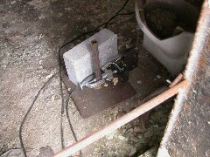
“Pandemonium” is a 15-minute computer-driven work that produces tapping noises in Cell Block Seven of the decaying 19th-century building (officially called a “stabilized ruin” by the folks at the admission desk, who make you sign a liability waiver before entering).
The tapping noises-produced by 120 motorized low-tech gizmos with sticks that tap on pipes, bed frames, toilet bowls and the like in the cells-build up and slow down in a kind of call-and-response fashion.
(above is detail shot of a drum stick hitting a toilet)
But the piece is an episodic parade of sounds-funeral drumbeat, executioner’s drumbeat, ticking clock, hammer on anvil, metal ball bouncing down metal stairs, muffled thud-that for all the noise has little intellectual or emotional reverberation.
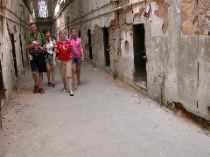
Funded in large part by the Philadelphia Exhibitions Initiative, “Pandemonium” evokes little Olivers banging on their tin cups-which is apt for a building Charles Dickens visited in his early years. The work also evokes prisoners banging on prison bars to instigate a revolt, something visualized so often in Hollywood movies it’s a cliche.
(image is people walking through the cellblock. People mostly peeked in and walked on to other parts of the prison when I was there. If they strolled through, they didn’t linger.)
The biggest disappointment of the piece is its generic quality. It’s a pedestrian response to the wonderful wreck that is Eastern State, with its unique history of a failed idea (solitary confinement drove prisoners crazy instead of rehabilitating them). The piece eschews all discussion of crime, punishment, corruption, evil, justice, injustice and state’s rights vs. personal rights. In that respect it aims lower than many far more humble works that have appeared in the art program here.
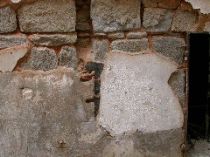
When Cardiff was invited to do this site-specific piece, she decided against doing a narrative walk, according to curator Julie Courtney. A flexible curator with the backing of a flexible funder will allow an artist creative freedom. (image is detail of the crumbling walls in Cellblock 7)
“Commissioning an artist-which is what I do-requires a leap of faith,” Courtney told me at the piece’s press opening. “You don’t know what you get.”
As with this piece, sometimes what you get is less than what you hoped for.
“Pandemonium” is a second-tier piece by a first-tier artist and her collaborative partner, who have produced first-tier pieces together elsewhere. What I don’t get is whether it’s second-tier because the artists cared so little about it or because they were just too busy to make something
better.
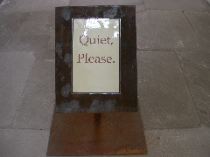
This collaborative piece could’ve been better had the artists’ voices and personalities-something present in spades in their other works-been used to personalize “Pandemonium.” While they’re solo Cardiff projects and not collaborations, works like “Her Long Black Hair” or the online interactive surveillance piece “Eyes of Laura” are far more compelling and engaging for being imbued with voice and spirit. For all its noise, this exhibit’s lack of voice is its downfall.
(the sign “Quiet Please” greeted the viewer at each end of Cellblock 7. In its school marm-ish fashion, it provided the only aspect of the artists’ voices in the entire project.)
cardiff, janet and george bures miller
“Pandemonium” Every Wed.-Sun., 10am-4pm. $4-$9. Through Nov. 30. Eastern State Penitentiary, 2124 Fairmount Ave. 215.236.3300.
“Her Long Black Hair” Every Thurs.-Sun., 10am-3:30pm. Free. Through Sept. 11. Public Art Fund, 59th St. and Sixth Ave., Central Park, New York, N.Y.
sketches
The multivenue “Still Standing” project, which begins Aug. 7, will document heretofore hidden slave histories in New Jersey-like the slave auction block in Camden’s Wiggins Park between 1761 and 1765, and a 435-acre Colonial-era slave plantation whose “Big House” was Pomona Hall, now the seat of the Camden County Historical Society. Camden resident Beverly Collins-Roberts organized the ambitious project, which includes lectures, a black film festival, exhibits of documentary photographs and more. See the schedule of events or call Collins-Roberts at 856.338.0608.
>> 2004 was a great year for the Walk Philadelphia architectural tour program, with 185 guided tours and a 14 percent increase in attendance over 2003. Unfortunately, the Center City District ended its three-year sponsorship of the program, and until a new funder is found, the program is on hiatus, according to a letter by the CCD’s Paul Levy posted on its website. Levy says the CCD is in discussions with a local organization interested in hosting the program, but meanwhile, no funding, no tours. Stay tuned. (R.F.)









